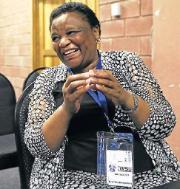
A Rhodes 老虎机游戏_pt老虎机-平台*官网 professor, Tebello Nyokong, who has made significant strides using photodynamic therapy to fight cancer is hoping someone will buy her research.
She wants to return to doing what she loves best – nurturing future scientists.
“I would love for a company to buy me out so that I can do my job of training students, because this becomes like business now,” Nyokong said.
While Professor Tebello Nyokong is excited about her contribution to the fight against cancer through the use of dye and light, she feels much of the work left is now to get it to the public. This therapy, still years from the market, is seen as an alternative to harsh treatments like chemotherapy and radiation.
Speaking to the Daily Dispatch from the 41st national convention of the South African Chemical Institution in East London on Tuesday, Nyokong said light has long been used to treat disease.
The treatment she researches uses blue dye – a modified version of the one used for blue jeans.
A doctor would take the dye and apply it to the skin where the cancer is and then shine a red light onto the dye, she said. “It’s the red light that starts killing the cancer in the presence of the dye.”
It can also be used on some internal cancers – like ovarian, throat and lung – where the dye is injected into the body but light can still penetrate.
Nyokong said the dye and light technique may one day replace chemotherapy and radiation, and could even work after tumours have been surgically removed to ensure all cancer is eliminated.
Nyokong stressed that her research was a contribution to a treatment that was not new – it was introduced in Europe in 1976.
“What they did then was to go to an abattoir, take blood from there, remove iron from this blood, dry it and use it to treat cancer.
“The problem was when you then injected it into the patient, it went everywhere in the body, not just to the cancer.
“So when the patient went into the sun, it would act like chemo and kill everything,” she said.
What makes Nyokong’s research different is that she has discovered how to focus the treatment on where the cancer is.
“We take these dyes and combine them with nanoparticles” to deliver them to the cancer zone.
Nanoparticles are increasingly being used for drug delivery due to their minute size.
“We are in the pre-clinical test phase – the step before we can start working with humans.”
Nyokong said it would be a number of years before the treatment became available.
By Vuvu Vena
Picture: Stephanie Lloyd
TIME TO MOVE ON: Professor Tebello Nyokong, from Rhodes 老虎机游戏_pt老虎机-平台*官网, explains at a convention in East London this week how the process of light therapy works in the treatment of cancer patients
Source: Daily Dispatch
